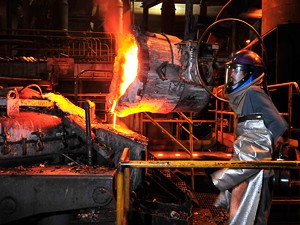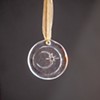Published December 7, 2011 at 9:29 a.m.
Entering the slate-blue industrial plant that lies on the southern outskirts of Randolph, along Route 12, is like passing through a portal back in time. The orange, ferrous haze that hangs in its dark, cavernous halls recalls the Industrial Revolution, when sooty, muscle-bound workers poured smoldering cauldrons of liquid fire into the raw materials that powered a growing nation.
This is the foundry of Vermont Castings, where each day 85 tons of molten metal are forged into cast-iron stoves, barbecue grills and cookware. Its fiery core is a gritty, beastly hot place, with extremes of size and temperature that overwhelm the senses.
Even the word “foundry” harks back to a simpler age. When it was built, in 1979, this was the first foundry to open in North America in decades. But it enabled Vermont Castings to innovate, reenvisioning the woodstove as something different from the dirty, ugly and inefficient potbelly furnace. Today, its iconic New England designs, which were copied throughout the industry, incorporate 21st-century technologies that make them cleaner burning, highly efficient and a growing component of the green-energy revolution.
Says Burlington industrial designer Paul Henninge, Vermont Castings “set the standard, and the rest of the industry has been playing catch-up ever since.”
However, the picture isn’t all warm and toasty. Statistics suggest that the domestic hearth and stove industry has been slow to reignite after the housing and construction bubble burst, and the coming years could snuff it out entirely. Vermont Castings and its Green Mountain rival, Hearthstone Stoves of Morrisville, compete against stove makers that have moved their operations overseas. The Randolph company has bucked industry trends by investing in new equipment and bringing dozens of manufacturing jobs back to Vermont from China.
But survival is still tricky in a year like this one, when winter arrived late, new home construction remains flat, and consumers are wary of making costly discretionary purchases. The question is, will the company that virtually invented the classic Yankee woodstove survive?
My guide through the foundry is manager Bob Wright, who has been at Vermont Castings for 30 years, almost as long as the company has been in existence. Since then, Vermont Castings has changed hands several times, but Wright has stayed. As he puts it, “Once a foundryman, always a foundryman.”
We walk past a vast storage room where an electromagnet hoists hundreds of pounds of scrap iron, mostly automobile rotors and drums, from a towering pile. One hundred percent of the iron that is melted and poured in this foundry is salvaged, making Vermont Castings one of the state’s largest recycling plants. About 100 people work here, and another 140 are employed just down the road at Vermont Castings’ manufacturing plant in Bethel.
The scrap iron from countless New England brake jobs is soon melted down in three electric furnaces, each of which holds 27 tons of molten metal. Every 15 minutes, a furnace tilts on hydraulic cylinders and pours liquid iron into a huge ladle suspended from a crane overhead. Metal sparks fly everywhere as the lava-like flow hits the ladle at 2700 degrees Fahrenheit.
The foundry runs only four or five days a week, but the plant “holds” molten metal around the clock, all year long. As Wright explains, “This facility is not the type that you can just turn off. Once you start it, it’s got to keep going.”
Case in point: Vermont Castings was physically undamaged by the flooding from Tropical Storm Irene. The following day, however, Wright got a call from Central Vermont Public Service informing him that the last remaining transmission line to the plant had just slid into a river, and power could be out for days. Fortunately, the plant had backup generators. If Wright had been forced to drain the furnaces, the foundry would have had to shut down entirely and restart — at a cost of a half million dollars.
The “cast” in cast-iron production is made of black silica sand. It’s a fine, malleable, clay-like substance that coats the floors of the entire building. The sand is shaped using pattern plates that compress it into 400-pound molds. A computer-automated machine called an autopour injects the liquid metal into the sand molds. The “tolerances” of the sand are so precise, Wright explains, that it can hold an impression as detailed as a fingerprint.
“We’re making furniture here,” he says. “This stuff will sit in living rooms and family rooms, and it’s got to look good. So the quality control of the molding sand is critical.”
In less than a minute, the poured metal cools to solid form. It continues cooling as it moves along a conveyor belt, then enters a huge oscillating tube that resembles a water-park chute on bedsprings. Inside, the sand mold is shaken loose from the iron — the sand is constantly recycled — until recognizable parts of cast-iron stoves emerge from the other end.
The foundry pours about 3500 molds per day of various shapes and sizes. Some days, the plant produces cast-iron cookware for Lodge, a Tennessee-based cookery company, and puts out about 5000 pans per day.
Most products are ready to be boxed and shipped within two hours of pouring. Such rapid turnaround time gives Vermont Castings a major advantage over its competitors in China, Wright explains, where shipping can take as long as six weeks. Most of the parts, though, go down the road to Vermont Castings’ Bethel plant. There, cast-iron and steel stoves are assembled, painted or enameled, tested for airtightness and given the finishing touches before being packaged and shipped to distributors nationwide.
Rick Grant, manufacturing manager at the Bethel plant, walks me through the facility. He says that virtually every part of the finished stove, except for the glass and handles, is now made in Vermont. Even the wood pallets the stoves are shipped on are constructed from timber cut within a 100-miles radius.
Grant proudly shows off a new, high-tech laser cutter that Vermont Castings purchased a few years ago. It enabled the company to bring all of its sheet-metal fabrication back from China. Today, the laser cutter runs around the clock, producing not only steel stoves but also parts for barbecue grills. In fact, many consumers are more likely to recognize the Vermont Castings name from those top-of-the-line grills than from its woodstoves. For about five years, the company sold a quarter million of them annually through Lowe’s and Home Depot.
At the end of the assembly line is a roll of American-flag stickers, which are slapped onto every crate before it rolls out the door. Says Grant, “Our people take a lot of pride in these stoves. And so do our customers.”
The woodstoves that Vermont Castings virtually invented are such iconic fixtures in New England that it’s hard to believe they didn’t exist before the 1970s. There’s a lot of history alloyed in those cast-iron hearths, from 18th-century architecture to the birth of the Environmental Protection Agency to the Y2K scare.
The woodstove industry was reborn in the United States following the 1973 Arab oil embargo, when fuel prices spiked, worldwide oil supplies dwindled, and Americans rediscovered wood as a home-heating fuel.
Before the ’70s, most woodstoves weren’t the ornate pieces of living-room décor they are today. They were big, ugly, sooty furnaces that were found mostly in the homes of farmers and the working poor.
Because most of those woodstoves weren’t airtight, they were smoky, dangerous and inefficient. They needed frequent tending, making it difficult to heat a house all night. Many stoves of that era were built by back-to-the-land hippies who welded them together from scrap metal. Some, like Vermont Castings founder Duncan Syme, became backyard entrepreneurs.
Vance Smith and Al Wilker were two of Syme’s earliest and most influential stove designers. In the early ’70s, Smith had just graduated from Harvard University with a master’s degree in architecture and an interest in alternative fuels. Like many creative types of her generation who moved to Vermont, she came for the lifestyle and never left.
Syme wasn’t an engineer by training, Smith recalls today, but a sculptor with a fine-arts degree from Yale. He wanted to create something that was functional and yet looked nice in a family room.
“In those days, either you couldn’t get [a woodstove] at all, or they were just too ugly,” she says. “Everyone else was making stoves that were appliances. Duncan wanted to make stoves that were furniture, that were sculptures.”
Hence his decision to work with cast iron, a metal that lends itself well to molding into intricate patterns. For a time, Syme sourced his cast iron from European foundries, but that soon became prohibitively expensive. So in 1979, he and his business partner, Murray Howell, built the foundry in Randolph.
Early on, Syme hired Smith as a design consultant. At her new job, she met Wilker, who became her business and life partner. The two live together in Brookfield and now have their own firm, Red House Design, where they craft wood- and gas stoves for other companies. (Neither they nor Syme are currently involved with Vermont Castings.)
Wilker explains that, as a native New Englander, Syme admired the Federal architectural style indigenous to 18th- and 19th-century Vermont. Notably, he incorporated its prominent feature of the fanlight, a semicircular or semielliptical window above a doorway. Visitors to Randolph, Bethel and other Vermont towns can see buildings that resemble Vermont Castings’ original stoves.
Perhaps most importantly, Smith adds, Syme capitalized on a design innovation of the late 1970s to incorporate glass into his stoves that wouldn’t get dirty, so the flame remained visible. Suddenly, a woodstove wasn’t just an appliance but a hearth that conveyed comfort, warmth and security. Like the traditional hearths of American architecture, the woodstove became a central feature of the family room, something that drew the eye — and demanded artistry in its design.
Syme didn’t invent soot-free glass, Smith emphasizes, but Vermont Castings popularized its use, and the rest of the industry quickly followed suit. This helps explain why so many woodstoves still resemble Vermont Castings’ designs.
“Lo and behold, it was pretty and it held a fire,” Smith says. “And soon everybody wanted one.”
In the early days of the company, Smith and Wilker wore many hats. Smith didn’t design Vermont Castings’ first stove, the Defiant, but she had a hand in designing the second, the Vigilant. As a former ad designer for Mother Earth News, one of the original DIY mail-order rags, she helped with Vermont Castings’ direct marketing in the years before it had a distribution network.
“Selling consumer durables over mail order is not an easy thing to do,” Smith recalls. “But the demand was so great, and the way they made the company out to be, which was warm and fuzzy and comfortable, it just took off.”
Indeed. In the early 1980s, Vermont Castings would host owners’ outings in Randolph that attracted thousands of people. Then, in 1983, Howell, Syme’s partner, died of a brain tumor. After a series of unprofitable business moves, the company was sold to a Canadian firm. Vermont Castings changed hands several more times in the ensuing years and is now owned by Monessen Hearth Systems of Paris, Ky.
Meanwhile, up north, a second classic Vermont stove maker emerged from the fray. In the late 1980s, the industry underwent a dramatic upheaval when the EPA adopted new emissions standards for all woodstoves. Most of the “backyard welders,” as Wilker calls them, couldn’t comply, and about half went out of business virtually overnight. Others were forced to dramatically retool their enterprises to stay alive.
Among those that did was Hearthstone Stoves. Hearthstone popularized soapstone, a highly durable material used for centuries to warm homes. It’s attractive and radiates heat evenly for hours.
Although Hearthstone declared bankruptcy in 1988, it was bought and reorganized the following year by a Spanish firm, Hergom. Like Vermont Castings, Hearthstone still produces some of the finest wood- and gas-fired stoves in the world.
Today, Hearthstone’s extensive product line includes sleek and contemporary designs, including several upright, or “portrait,” European styles. Hearthstone president Dave Kuhfahl boasts that his company’s Euro Collection has created an enormous buzz in magazines and trade publications. The Tula model, for example, is “one of the most efficient stoves in the world.” Rated at 30,000 Btus, it has an efficiency of 88 percent.
“That’s as good as the boiler in your house,” Kuhfahl says. “But I wish it sold as well as its efficiency.”
Kuhfahl admits that if Hearthstone “threw out the entire [Tula] line, it wouldn’t affect my bottom line very much. There’s an excitement about it, but the customer who loves it doesn’t actually buy it.” Hearthstone’s best-selling model is still the Heritage, which is rated at 55,000 Btus and has a classic New England style rooted in the original Vermont Castings designs.
In the late 1990s, the woodstove industry underwent another resurgence. Earlier in the decade, 75 percent of Hearthstone’s stoves were gas-fired models. But as Y2K approached, and with it fears of a global technology meltdown, the balance soon shifted back to wood.
“Everyone thought the world was going to end and they would have to have a woodstove. So they all bought one,” Kuhfahl says with a chuckle. “And, of course, we encouraged them.”
For the next few years, the American stove industry enjoyed robust sales. From 1998 to 2005, shipments of wood-, pellet- and gas-fired stoves grew from 2.3 million to 2.8 million annually, according to figures from the Hearth, Patio and Barbecue Association. But by 2007, sales had dwindled to 1.9 million; last year, they were at 925,000. Only electric-stove sales have increased since 2008.
Despite this worrisome trend, both Vermont Castings and Hearthstone continue to be industry leaders, largely because they haven’t compromised on their quality. Iconic New England woodstoves are still desired the world over. “The Japanese just love these solid, American-made stoves,” says Kuhfahl.
Kuhfahl admits to some uncertainty about his company’s prospects. New EPA emissions standards are due out in the next few years, he notes, which will require wood, gas and pellet stoves to be even cleaner and more efficient. At the same time, those new rules will make it harder for Vermont’s stove makers to compete with cheaper models coming from the Pacific Rim.
Still, he, Smith and Wilker express cautious optimism about the future of Vermont woodstove makers. As Kuhfahl puts it, “Any time there’s discomfort in the world, people make apple pies and nest in front of their woodstoves.”
More By This Author
Speaking of Profile
-

Young and Restless
Jan 12, 2011 -

Bench Mark
Mar 3, 2010 -

Past Perfect
Feb 10, 2010 -

A Very Filthy Christmas
Dec 2, 2009 - More »
Comments
Showing 1-1 of 1
Comments are closed.
From 2014-2020, Seven Days allowed readers to comment on all stories posted on our website. While we've appreciated the suggestions and insights, right now Seven Days is prioritizing our core mission — producing high-quality, responsible local journalism — over moderating online debates between readers.
To criticize, correct or praise our reporting, please send us a letter to the editor or send us a tip. We’ll check it out and report the results.
Online comments may return when we have better tech tools for managing them. Thanks for reading.













































